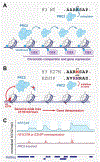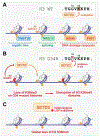Epigenomic Reprogramming as a Driver of Malignant Glioma
- PMID: 32916125
- PMCID: PMC8248764
- DOI: 10.1016/j.ccell.2020.08.008
Epigenomic Reprogramming as a Driver of Malignant Glioma
Abstract
Malignant gliomas are central nervous system tumors and remain among the most treatment-resistant cancers. Exome sequencing has revealed significant heterogeneity and important insights into the molecular pathogenesis of gliomas. Mutations in chromatin modifiers-proteins that shape the epigenomic landscape through remodeling and regulation of post-translational modifications on chromatin-are very frequent and often define specific glioma subtypes. This suggests that epigenomic reprogramming may be a fundamental driver of glioma. Here, we describe the key chromatin regulatory pathways disrupted in gliomas, delineating their physiological function and our current understanding of how their dysregulation may contribute to gliomagenesis.
Keywords: chromatin; epigenomics; glioma; transcription.
Copyright © 2020 Elsevier Inc. All rights reserved.
Conflict of interest statement
Declaration of Interests
The authors declare no conflict of interest.
Figures






References
-
- Ahmad K, and Henikoff S (2002). The Histone Variant H3.3 Marks Active Chromatin by Replication-Independent Nucleosome Assembly. Molecular Cell 9, 1191–1200. - PubMed
-
- Allis CD, and Jenuwein T (2016). The molecular hallmarks of epigenetic control. Nat Rev Genet 17, 487–500. - PubMed
-
- Angel A, Song J, Dean C, and Howard M (2011). A Polycomb-based switch underlying quantitative epigenetic memory. Nature 476, 105–108. - PubMed
Publication types
MeSH terms
Substances
Grants and funding
LinkOut - more resources
Full Text Sources
Medical

